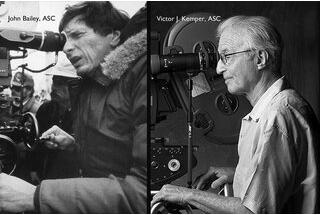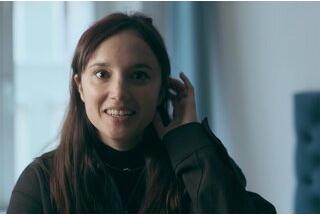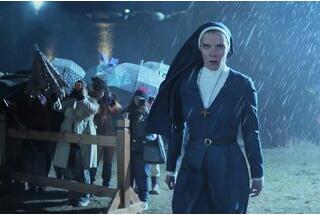Cinematographer Thomas Hardmeier, AFC, discusses his work on Jean-Pierre Jeunet’s film "Big Bug"
The husband, the ex-wife, and the cyborg“At the start, Jean-Pierre wanted to make a small film. A story in a unique place, that wasn’t too expensive to make, and that would be quick to shoot,” remembers Thomas Hardmeier. “And amongst the first directives he raised was the need of having as much lighting as possible integrated into the ceilings or walls of the sets, so that we could be as free as possible with the actors. In the end, the film took quite some time to come together financially, and when we entered pre-production, several years after I’d first read the screenplay, Jean-Pierre immediately brought up the idea of having the light in the ceiling again, insisting that it was important to have the setup be as quick as possible. His need to spend time with the actors was crucial on this film, because of all the projects he’s worked on, this one has the most dialogue.”
Interested in the behind-closed-doors challenge on this film, the cinematographer dived into the preparation of the project, which gradually turned into a film shot entirely in studio. “I remember that there were a number of discussions about an on-location option, especially for the exterior shots of the house… But given the unity of place, of time, and the interactions with the area around the house (garden, street, etc.), we agreed that it would be more logical to shoot in studio. We also wanted to be able to create several locations inside the same set to break with the theatrical aspect the project might otherwise have had. We tried to give depth to the big living room, for example, using the hothouse we put in the middle of it. We also used the bedrooms, which were supposed to be upstairs, on another stage. Lastly, the large picture windows with a view outside played a dramatic role in certain scenes… All of that was part of our decisions to get away from an overly monotonous bell jar feeling.”
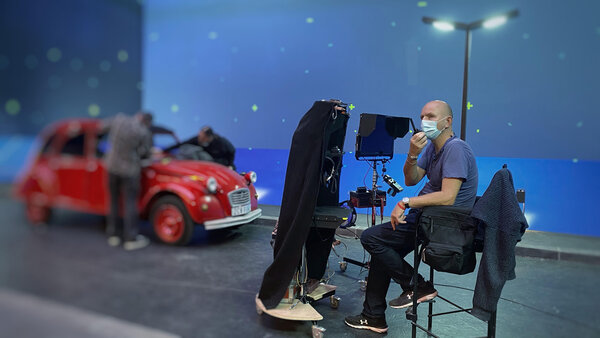
Although unity of place is a central parameter of this film, it’s also important to discuss the unity of time, because the entire story takes place over a period of about thirty hours… “The change in lighting mood was another way for us to vary the images and the staging as the protagonists become incarcerated in their home. The fact that we were able to shoot the film in chronological order also greatly helped us to refine the effects. My idea was naturally to shift to a darker mood when the robot Yonix enters the scene. By relying on a battalion of over 100 SkyPanel S60s controlled by a 16-bit lighting console installed behind the ceiling designed by Aline Bonetto, we were able to easily titrate these effects and be audacious with color. Additionally, two 18kW Arrimax placed outside helped to create sunlight effects, which were filled out by a blue screen for the view on the rest of the housing development.”
Since Jean-Pierre Jeunet is not accustomed to filming behind-closed-doors movies, he rewatched many classic films for inspiration: “One of these films was Joseph Losey’s The Servant. He felt it was important to observe how this genre handled unity of place, how they placed the camera to film the actors, and how they varied the angles to avoid monotony and organize the shooting schedule. What I found exciting with Jean-Pierre was his precision, how demanding he was about the image, and his artistic sense with regard to editing. He is an extremely experienced director who wants to imprint each scene with his style, in which black humor and a certain retro style coexist. He’s also a hard worker, he prepares each scene with his own photo board, framed with stand-ins… or sometimes a more elaborate storyboard when the special effects require it. He shoots all of his films solely with a film camera. This is increasingly rare given the current prevalence of digital cinematography. It’s extremely pleasant as an operator because you really get to work on the image with him, and not in a way that is separated from the staging.”
When he is questioned about Jeunet’s style, Thomas Hardmeier replies directly: “Of course, he loves short focal lengths, always placed at a low-angle or a high-angle… in any case, never at eye-level with the actors! In that way, his style doesn’t change. But he also likes deep focal lengths, and so the cinematographer has to be able to give him enough aperture so that as much as possible can be in focus on screen. Because Netflix asked us to supply 4K images, I had initially expected the film would be shot with an Alexa 65. But I quickly realized that’d be shooting myself in the foot for when Jean-Pierre would ask me, as always, for greater depth of field. In the end, we opted for the Alexa LF, which seemed sharp enough to me without compromising the backgrounds. But because Jean-Pierre has shot all of his films in 35mm (except TS Spivet, shot in 3D digital, but not in full frame), he is very familiar with focal lengths. In order not to destabilize him, we rebaptized each Signature Prime lens (covering the full frame) by putting the equivalent Super 35 focal lengths on them. So, the 25 was rebaptized the 16mm, which is Jean-Pierre’s reference focal length. By shooting his film mainly at 2000 ISO on the LF, I was able to open the aperture from 5.6 to 8. However, this caused a lot less distortion, I think, on the 25mm compared to the traditional 16mm or 18mm.”
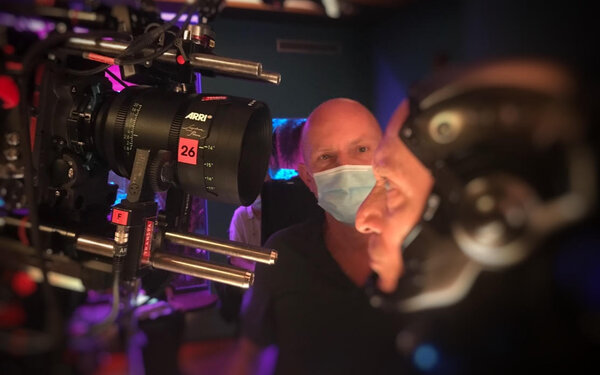
Of all the emblematic scenes in the film, one of them is particularly in the tone of Jean-Pierre Jeunet’s cinema. This is the scene with the little dog and the alarm signal… “At this point in the story, the characters are stuck behind their unbreakable windows, and they suddenly place all of their hopes on the small dog to free them from their domestic prison. I feel Jean-Pierre is truly most at home in scenes like this. There’s almost no dialogue, almost everything literally is transmitted through the image. In order to shoot it, we proceeded in two separate steps, first working with the actors, and then the following day with the dog, especially for everything that happens around the pole. I remember in particular very exacting discussions as to the nature of the pole, its height and its handle, so that the dog would be able to be able to grab it and tear it off… In the interior shots, you can clearly see the work done by Aline Bonetto and her crew in terms of the ceiling height and size of its cells. Also, the many RGB LED bands (installed by Led Box, a company that often works in fashion and on TV studios) controlled by the same console, and that gave definition to the walls and the details of the set using light. Similarly, on the exterior shots, the façade of the house is also decorated by the LED bands, which give a simultaneously retro and modern appearance, which Jean-Pierre likes. For the reverse traveling shot that ends up circling around the alarm pole, we used a simple combination of a dolly and a slider. The blue screens began on the other side of the street, which allowed the FX team to add the rest of the houses in and prolong the perspective using 3D images. The amount of blur was also controlled in postproduction.”
Another challenge, besides the set-up speed Jean-Pierre desired, were the many reflections on the windows of the set. “The picture window, of course, but also the greenhouse in the middle of the living room, were sources of camera reflections or other types of reflections. In order to limit the damage, I asked Aline Bonetto to make the greenhouse not a round shape, but a series of cut shots that would be easier to handle. In any case, all of the lighting in the wide shots came from prop sources in the interior shots, and I didn’t add much, except for a ring light for some scenes, but I made sure to dim it when getting close to faces.”
Asked about the importance of having the lighting controlled in real-time via a console, like in a show or a stage performance, Thomas Hardmeier admits that a film such as BigBug would have been hard to make without the advances offered by RGB LED technology. “Without it, the film would definitely have been different. With control via the console, I truly felt total freedom, as did Jean-Pierre. You can test out pretty much anything you have in mind, whether in terms of color or contrast ratio… and then apply it instantly on set. It’s really a very intuitive approach, with a very precise live-action control.”
Did this precision control enable them to spend less time in postproduction? “Not really,” replied Thomas Hardmeier. “On BigBug, we spent four weeks in color timing. I’d say that the lighting and the sets are precisely defined with this method, but there is still a need to refine the rendering of different faces, especially when you can’t add light to each actor’s face with external light sources… And then directors such as Jean-Pierre remain highly demanding through that last phase and spend as much time refining the image of their film as they would have anyway.”
In 2045, artificial intelligence is everywhere. So much so that humanity counts on it to fulfill its smallest desires— even the most private ones… In a quiet, residential neighborhood, four domestic robots suddenly decide to take their masters hostage in their own home. Locked in together are a not-quite-blended family, their nosy neighbor and her enterprising sex robot, who are all forced to put up with one another in an increasingly hysterical environment! Meanwhile, outside, the Yonyx, who are the latest generation of androids, are trying to take power. As the threat draws closer, the humans cheat one another, envy one another, and tear one another to shreds under the bewildered gaze of their domestic robots. What if it were instead the robots who had a soul… or not?
BigBug
Production: Eskwad (Richard Grandpierre, Frédéric Doniguian) for Netflix
Director: Jean-Pierre Jeunet
Screenplay: Guillaume Laurent and Jean-Pierre Jeunet
Cinematography: Thomas Hardmeier, AFC
Set Design: Aline Bonetto, ADC
Costumes: Madeline Fontaine, AFCCA
Makeup: Nathalie Tissier.
(Interview by François Reumont for the AFC, translated from French by A. Baron-Raiffe)
 En
En
 Fr
Fr
